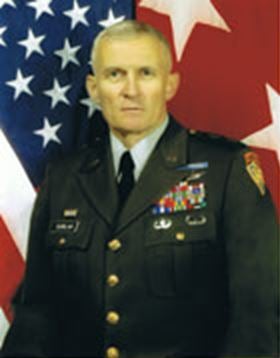- Major General
- Balkans & Desert Storm
Biography
Major General Kenneth J. Quinlan is a native of Warwick, Rhode Island and a 1968 graduate of Warwick Veterans Memorial High School. Ken was an outstanding scholar and played on the football team for four years. At graduation, he received the “Outstanding Senior Student Award” for excellence in leadership, academics and sports. Ken entered the University of Rhode Island in the fall of 1968 and enrolled in the four-year Army ROTC program. He was on the football team and a member of the Phi Gamma Delta Fraternity.
Ken was selected for the first class of cadets to attend Airborne School at Fort Benning, GA in 1971, earning his Airborne Wings. He also successfully completed the ROTC Flight Program earning a private pilot’s license. Ken served as the Executive Officer for the Corps of Cadets. In January 1973, Ken graduated from URI with a Bachelor of Science Degree in Civil Engineering and was commissioned as a Second Lieutenant of Infantry. He was a Distinguished Military Graduate.
Second Lieutenant Quinlan was assigned to the B Company, 2-327th Infantry, 101st Airborne Division as a Airmobile Rifle Platoon Leader where he earned the Air Assault Badge. Immediately following this initial assignment, First Lieutenant Quinlan entered Rotary Wing Training at Fort Rucker, Alabama. He returned to the field with an assignment to 3d Squadron, 5th Air Cavalry in the 9th Infantry Division at Fort Lewis, Washington. His duties included Aero Scout Section Leader flying the OH-58 as well as Aero Weapons Platoon Commander flying the AH-1 helicopter. Captain Quinlan commanded A Company in the 2nd Infantry Division, Fort Lewis, Washington.
The next assignment was E Troop (Air) 1st Cavalry, Fort Wainwright, Alaska as the Aero Weapons Platoon Commander, followed by duty as the Operations Officer. He successfully established an aerial gunnery facility in an austere Alaskan environment.
Captain Quinlan was assigned to Troop D (Air), 1/26th Cavalry, Quonset Point, Rhode Island as a full-time manning Operations Officer. He greatly assisted in the development and execution of a comprehensive Troop Training Program that energized the full potential of a great Air Cavalry unit in the Rhode Island Army National Guard. After promotion to Major, he attended Command and General Staff College and the School of Advanced Military Studies (SAMS) at Fort Leavenworth, Kansas culminating with a Master of Military Art and Science Degree.
During Operations Desert Shield and Desert Storm, Lieutenant Colonel Quinlan served as the Operations Officer of the 101st Aviation Brigade. The mission of the division was to maneuver on the left wing of the XVIII Corps. His brigade conducted numerous air assaults all the way to the edge of the Euphrates River cutting Highway 8 and sending enemy forces reeling back with their escape route blocked. He was responsible for the training and employment of ten aviation battalions, 350 helicopters and thousands of soldiers.
Following combat operations, Lieutenant Colonel Quinlan was reassigned to the 82d Airborne Division assuming command of 1-17 Air Cavalry Squadron. His unit transitioned from AH-1 and OH-58 helicopters to field the first new Kiowa Warrior Squadron for the Army. Colonel Quinlan assumed command of the 10th Aviation Brigade at Fort Drum, New York.
Selected for Brigadier General, he was assigned to the 1st Armored Division. BG Quinlan trained, deployed and led a Multinational Brigade Task Force, a combined combat force of over 8,800 personnel from eight nations deployed to Kosovo and the former Yugoslav Republic of Macedonia in support of Operation Joint Guardian.
Returning to the Balkans, Brigadier General Quinlan was assigned as the G-3 Operations Officer for SFOR in Bosnia. During the next year, Brigadier General Quinlan was instrumental in overseeing bold actions generated by an exceptional intelligence system that gained the initiative over parallel power structures and empowered the international community to accelerate reform in Bosnia.
Returning to the United States, Major General Quinlan assumed the duties of Commandant of the Joint Forces Staff College in Norfolk, Virginia. During his tenure, Major General Quinlan designed and implemented a Joint Advanced Warfighting School directed by the Chairmen of the Joint Chiefs of Staff to provide trained strategic plans officers for all the Regional Commands.
Major General Quinlan’s awards and decorations include: the Defense Superior Service Medal, Legion of Merit, Bronze Star Medal, Meritorious Service Medal, Joint Service Commendation Medal, Army Commendation Medal, Expert Infantry Badge, Senior Parachutist Badge, Air Assault Badge, Master Army Aviator Badge, and Ranger Tab. Major General Quinlan has spent his entire life serving his community and nation during peace and war. His exemplary devotion to duty, personal bravery and outstanding leadership is in the highest traditions of the military service and reflect great credit upon himself, his family and the University of Rhode Island.
Major General Quinlan resides in Huntsville, Alabama with his wife Lynn.
Education
1973

